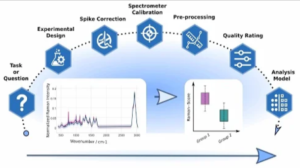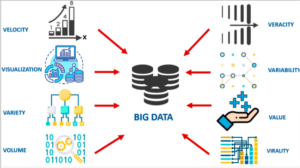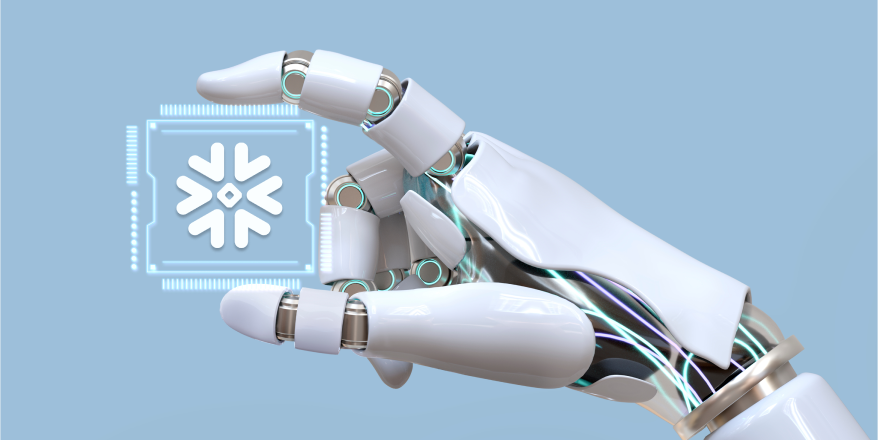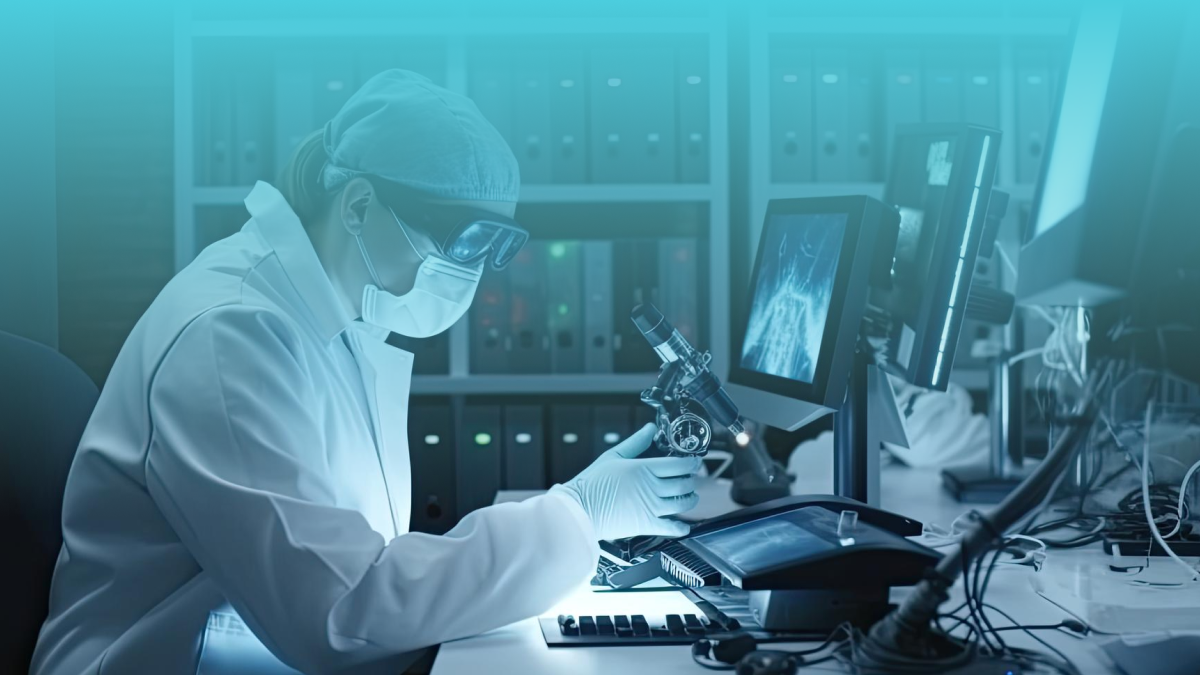How AI and Big Data is powering Raman Spectroscopy
Introduction:
Raman spectroscopy, a powerful analytical technique based on light scattering, has emerged as a game-changer in molecular diagnostics, drug detection, and food safety. The molecular fingerprints it provides enable precise identification and quantification of substances. Due to its complexity and the huge amount of data generated, Raman spectra are difficult to analyze quickly. However, by leveraging AI and Big Data, real-time decision-making on Raman spectra has become possible. This synergy between the effectiveness of Raman spectroscopy, and the decisioning ability of machine learning is creating new possibilities for usage across multiple domains.
This article examines how the power of this unique combination is transforming these critical fields and shaping the future of analytical science.

Overview of Raman Spectroscopy:
In Raman spectroscopy, when samples are illuminated with a laser, a small fraction of the reflected light shifts to different wave-lengths. Analyzing this shift provides detailed information about the sample’s chemical composition and structure, as well as the molecular interactions within it. Molecular diagnostics, drug detection, and food safety applications can all benefit from this non-destructive technique, because it distinguishes even subtle differences among similar molecules.
Furthermore, Raman spectroscopy offers fast analysis of samples with little preparation, enabling real-time insights in diverse settings, such as clinical laboratories and law enforcement checkpoints. As the cornerstone of modern analytical science, its ability to produce precise, reliable, and actionable data has cemented its role.
The Role of Big Data in Raman Spectroscopy
The Raman spectroscopy process generates vast quantities of complex spectral data, especially when used for disease diagnosis, drug analysis, and food testing. An individual Raman scan of a sample can produce thousands of data points, each representing a unique molecular vibration. Analyzing multiple samples or detecting trace contaminants requires extensive processing of spectral datasets in drug detection and food safety. The management, organization, and analysis of this data requires Big Data tools, which are necessary for its efficient storage, organization, and analysis. Using cloud-based systems and advanced computing platforms, large datasets can be handled, while machine learning algorithms extract meaningful insights from spectral data.
Additionally, Raman data can be integrated with other sources of data, such as genomics for disease profiling or chemical databases for drug identification, to enhance accuracy and depth of analysis. The synergy between Raman spectroscopy and Big Data not only speeds decision-making but also enables predictive modeling and real-time monitoring, transforming how healthcare, enforcement, and food safety are approached.
How AI Enhances Raman Spectroscopy:
AI has become a cornerstone in overcoming the challenges of Raman spectroscopy, significantly enhancing its capabilities across various applications.
- Data Preprocessing:
One of the first steps in analyzing Raman spectra is cleaning the data. Machine learning algorithms, such as those based on AI, excel at tasks like noise reduction and baseline correction, which are essential for ensuring accurate and reliable spectral measurements. Artificial intelligence automates these data preprocessing steps to minimize human error and save time, allowing researchers to focus on interpretation rather than data cleaning.
- Spectral Analysis and Interpretation:
AI models, particularly deep learning and neural networks, identify complex patterns in Raman spectra. Models such as these can classify spectra with a high degree of precision, enabling applications such as disease diagnosis, drug identification, and food adulteration detection. Using AI, for instance, cancerous and healthy tissue can be distinguished by subtle spectral differences or chemical compounds can be detected in a mixed sample using chemical spectra.
- Quantitative Analysis:
Quantitative analysis enabled by AI goes beyond quantitative identification by correlating spectral features with molecular concentrations. Applications such as determining the purity of drugs in law enforcement scenarios or measuring biomarker levels in clinical diagnostics make use of this technique.
- Real-Time Detection:
The ability to detect in real time is perhaps one of t he most transformative aspects of AI-powered Raman spectroscopy. Portable Raman devices with AI algorithms can provide instant results, making them ideal for drug detection, food safety inspections, and even point-of-care diagnostics on-site. The ability to render results in real-time speeded up decision-making and improved the practicality of Raman spectroscopy in field applications.

NutaNXT Leverages AI and Big Data in Molecular Diagnostics:
NutaNXT has effectively harnessed the power of AI and Big Data through Raman spectroscopy to enhance molecular diagnostics across various domains. This analysis will detail their applications in three key areas: quantitative analysis, detection and prevention of food adulteration, and drug detection & law enforcement.
NutaNXT has developed a number of proprietary techniques around Raman spectroscopy to enhance sample identification and analysis. These include:
Calibration Curves: NutaNXT has used advanced chemometric techniques to create reference Raman spectra (calibration curves) across a wide database of products. Leveraging these techniques allows us to achieve a higher signal-to-noise ratio, resulting in reliable measurements.
Automated Data Analysis: Utilizing machine learning, NutaNXT enhances data interpretation from Raman spectra. Our proprietary algorithms automate the extraction of relevant features, enabling rapid and accurate assessments of sample compositions. For instance, statistical methods such as Principal Component Analysis (PCA) are employed to improve quantitative results reproducibility and reliability.
Image Augmentation Techniques: NutaNXT utilizes deep learning to enhance data interpretation of Raman spectra, from noise elimination in spectral generation, to feature extraction. These collectively result in better detection capability and enhanced model robustness.
Select Use Cases:
- Detection and Prevention of Food Adulteration
NutaNXT has applied Raman spectroscopy to detect food adulteration. Key elements of our solution:
Non-Destructive Testing: The non-invasive nature of Raman spectroscopy ensures rapid analysis of food products without compromising its integrity. It is particularly beneficial for maintaining consumer trust and adhering to safety regulations.
Comparative Spectral Analysis: NutaNXT uses Raman spectral analysis to identify contaminants in food items such as spices and oils. In addition to enhancing food safety, this method supports regulatory compliance by providing reliable assurances as to the authenticity of the product.
- Drug Detection and Law Enforcement
NutaNXT’s application of Raman spectroscopy supports law enforcement for drug detection:
Portable Spectrometers: The use of portable Raman spectrometers enables law enforcement agencies to conduct on-site analyses of unknown powders and liquids quickly. This capability is crucial for maintaining the integrity of evidence while providing immediate results.
Spectral Fingerprinting: NutaNXT’s systems can distinguish between various illicit drugs based on their unique spectral fingerprints. This facilitates timely decision-making during investigations, allowing law enforcement personnel to identify controlled substances rapidly and accurately.
Predictive Modeling: NutaNXT enhances investigation decision-making through AI-driven predictive models. These models can be used by law enforcement to assess risks associated with accurate identification of substances.
Conclusion:
In conclusion, the integration of AI and Big Data with Raman spectroscopy has revolutionized its applications in molecular diagnostics. By automating data preprocessing, enhancing spectral analysis, enabling quantitative measurements, and facilitating real-time detection, AI has significantly improved the accuracy, speed, and accessibility of Raman spectroscopy. Big Data tools have further amplified its potential by managing vast datasets, enabling predictive modeling, and integrating diverse data sources for deeper insights.
As these technologies continue to evolve, Raman spectroscopy, powered by AI and Big Data, is poised to become an indispensable tool in analytical science, driving innovation and improving outcomes across multiple domains.

